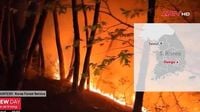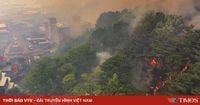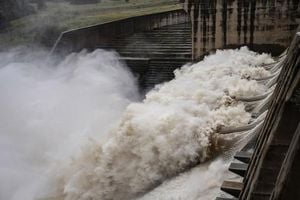On the afternoon of April 28, 2025, the city government of Daegu, South Korea, issued an evacuation order for over 1,200 residents as a large forest fire raged nearby. The fire, fueled by strong winds and dry weather, has caused significant damage to approximately 50 hectares of forest in less than two hours.
The blaze broke out around 2:00 PM local time on Hamji Mountain, located about 233 kilometers southeast of Seoul. As the flames spread rapidly, authorities took immediate action, closing a section of the Gyeongbu highway and mobilizing emergency services to contain the situation.
In response to the fire, the National Fire Agency (NFA) dispatched a formidable firefighting force, which included 28 fire trucks, 26 helicopters, and 202 personnel. These efforts were crucial, especially considering the dire conditions that led to the fire's ignition. The NFA issued an emergency response order roughly two hours after the fire began, activating national resources to combat the expanding inferno.
As of 6:00 PM on the same day, approximately 9.2 hectares of land had been affected by the fire. The NFA also raised a level 3 alert, the highest on its scale, as wind speeds exceeded 7 meters per second. This alert indicated that the damaged area could surpass 100 hectares and that firefighting efforts might take over 24 hours to fully extinguish the flames.
Fortunately, there have been no reports of casualties in this latest incident, which stands in stark contrast to a previous forest fire in South Korea that claimed the lives of nearly 30 individuals and destroyed numerous historical sites. The recent history of devastating wildfires has heightened the urgency of the current situation in Daegu.
Local authorities took precautionary measures by temporarily relocating evacuees to nearby elementary schools, ensuring their safety as firefighters battled the flames. The rapid response from firefighting teams and the coordination of local and national resources reflect the lessons learned from past disasters.
In March 2025, South Korea faced a catastrophic forest fire that ravaged approximately 48,000 hectares of land, equivalent to 80% of the area of Seoul. This earlier disaster saw 29 fatalities and left 41 others injured, marking it as one of the worst wildfire events in the nation's history. The scars of that event are still fresh in the minds of many, making the current situation all the more alarming.
On March 29, 2025, just a month prior to the Daegu incident, forest fires reignited in southeastern South Korea. Reports indicated that smoke was detected in the Andong area, about 190 kilometers southeast of Seoul, prompting local firefighting units to respond swiftly. The fires in March required the deployment of 11 helicopters, dozens of ground crews, and military assistance to combat the flames effectively.
The rapid escalation of these wildfires has raised concerns about climate conditions in South Korea. Experts point to the combination of dry weather and strong winds as factors that have contributed to the severity of these incidents. As the nation grapples with the reality of increasingly frequent and intense wildfires, discussions around preventive measures and response strategies are becoming more critical.
In light of recent events, the South Korean government is expected to review its wildfire management policies, aiming to implement more robust strategies for fire prevention and response. Community awareness and preparedness will also play vital roles in mitigating the impact of future wildfires.
As the situation in Daegu continues to develop, local residents remain vigilant, hoping for a swift resolution to the ongoing fire. The resilience of the community, coupled with the efforts of emergency services, will be pivotal in overcoming this latest challenge.
In conclusion, the recent forest fire in Daegu serves as a stark reminder of the ongoing threat posed by wildfires in South Korea. With the memories of past tragedies still looming, the urgency for effective wildfire management has never been clearer.





